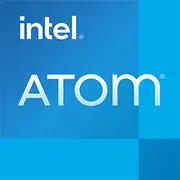Intel Atom Z3735G

Intel Atom Z3735G: An Ultra-Budget Processor for Basic Tasks in 2025
Introduction
The Intel Atom Z3735G is a processor released in 2014 that is still found in ultra-budget devices today. Despite its obsolescence, it retains niche applications due to its extremely low power consumption. In 2025, such chips are primarily relevant for specific scenarios. Let's explore who might need this processor today and for what purposes.
Architecture and Technology Process: 22 nm and Modest Ambitions
Codename and Technology
The processor belongs to the Bay Trail-T family and is manufactured using a 22 nm technology process. This is outdated even for the mid-2010s, but it provided the chip with record energy efficiency.
Cores, Threads, and Frequencies
- 4 Cores/4 Threads: All cores are physical, with no support for Hyper-Threading.
- Frequencies: Base frequency is 1.33 GHz, with turbo mode up to 1.83 GHz. However, due to a TDP of 2 watts, the boost lasts only a few seconds.
- Silvermont Architecture: Optimized for mobile devices but lags behind modern cores in IPC (instructions per clock).
Integrated Graphics
- Intel HD Graphics (Bay Trail): 4 execution units (EU), with a frequency of up to 646 MHz.
- Capabilities: Supports DirectX 11, 1080p video playback (H.264). Not suitable for gaming — even Minecraft at minimum settings barely achieves 20-25 FPS.
Power Consumption and TDP: Record Savings
TDP of 2 Watts — the main advantage of the Z3735G. It allows for:
- Elimination of active cooling (fans).
- Integration into compact devices: tablets, mini-PCs, IoT gadgets.
- Providing battery life of up to 10-12 hours in devices with a 30-35 Wh battery.
Limitations: Low TDP can be a double-edged sword. Under load, the processor quickly hits thermal limits, reducing its frequency. For example, while rendering a web page with video, cores can drop to 1.2 GHz in 2-3 seconds.
Performance: Minimum for Survival
Office Tasks
- Documents: LibreOffice, Google Docs work, but with delays when loading heavy files (20+ MB).
- Browser: 5-7 tabs in Chrome is the limit. YouTube 1080p is possible but may experience periodic stutters.
Multimedia
- Video: Local 1080p playback (H.264) is smooth. 4K or HEVC is not supported.
- Streaming: Netflix, YouTube — 720p works fine, 1080p may show artifacts.
Gaming
- Older Games: Half-Life 2, Portal — 30 FPS at low settings.
- Indie Projects: Stardew Valley, Terraria — playable.
- Modern Games: Even Among Us may require resolution reduction.
Turbo Mode: Practically useless. The boost of up to 500 MHz lasts 3-5 seconds, after which throttling occurs.
Use Cases: Who Is the Atom Z3735G Relevant For in 2025?
1. Educational Devices: Cheap tablets for schools (e.g., DragonTouch Y88X Pro 2025, $120).
2. Media Centers: Mini-PCs for video playback (e.g., connected to a projector).
3. IoT Devices: Terminals, information kiosks.
4. Backup Gadgets: “Just in case” devices for travel – reading, taking notes, calling via Zoom (at low resolution).
Not Suitable For:
- Freelancers — performance lags in Figma or Google Meet.
- Gamers — even cloud gaming requires stable video decoding.
- Photographers/Designers — Photoshop Elements 2025 won't run.
Battery Life: Long Life Without a Socket
Operating Time:
- Tablets with Z3735G and a 32 Wh battery — 8-10 hours of web surfing.
- Mini-PCs with an external battery — up to 24 hours in media player mode.
Power-Saving Technologies:
- Intel SpeedStep: Dynamic frequency adjustment.
- C-states: Turning off unused cores.
- Display Power Saving Technology: Automatically reduces screen brightness.
Tip: For maximum battery life, turn off Wi-Fi and Bluetooth, and use dark themes in applications.
Comparison with Competitors: Against Modern Rivals
AMD A4-5000 (2013):
- TDP of 15 watts, 4 Jaguar cores.
- Performance is 30% higher, but battery life is 2-3 times worse.
Apple A8 (2014):
- Geekbench 6 Single-Core — ~200. Twice as fast as Atom, but within iOS ecosystem.
Intel Celeron N4020 (2019):
- TDP of 6 watts, 2 cores. Despite having fewer cores, multi-threaded performance is 50% higher.
Conclusion: The Z3735G lags behind even budget chips from 2018-2020 but wins in price and battery life.
Pros and Cons: Is It Worth Buying in 2025?
Pros:
- Device prices: $100-$200.
- Silent operation (no fan).
- Compatibility with Windows 10/11 (with limitations), Linux.
Cons:
- No support for AVX, AES-NI — issues with security and modern software.
- Maximum of 2 GB of RAM (officially) — multi-tasking is impossible.
- Outdated ports: USB 2.0, micro-HDMI.
Recommendations for Device Selection
Form Factors:
- Tablets: Look for models with 8-10 inch screens (e.g., Chuwi Hi8 Pro 2025).
- Mini-PCs: Use for digital signage (MeLE PCG35).
- Hybrid Laptops: Keyboard + touchscreen (e.g., Linx 12X64).
Considerations:
1. RAM Size: Minimum of 4 GB (unofficially supported).
2. Storage: 64 GB eMMC is insufficient; seek models with SD card expansion.
3. Screen: IPS panel — reduces eye strain.
Alternatives for $200-300:
- Intel N100 (7 watts, 4 cores, 2023) — three times more powerful.
- Raspberry Pi 5 (for Linux enthusiasts).
Final Conclusion: Who Is the Atom Z3735G Suitable For in 2025?
This processor is suitable for those who:
- Are looking for a "one-year" device for a child.
- Need a cheap media player for a summer house.
- Are assembling an IoT project on a minimal budget.
Key Benefits:
- Does not require cooling.
- Can be powered by any power bank.
- Available in ready-made solutions "out of the box."
However, if the budget allows adding $50-100, it’s better to opt for a modern Celeron or Pentium Silver — you will gain many times more performance without sacrificing battery life. The Atom Z3735G in 2025 is a story about compromises, where the main argument is "cheap" rather than "practical."
Basic
CPU Specifications
Memory Specifications
GPU Specifications
Benchmarks
Compared to Other CPU
Share in social media
Or Link To Us
<a href="https://cputronic.com/en/cpu/intel-atom-z3735g" target="_blank">Intel Atom Z3735G</a>